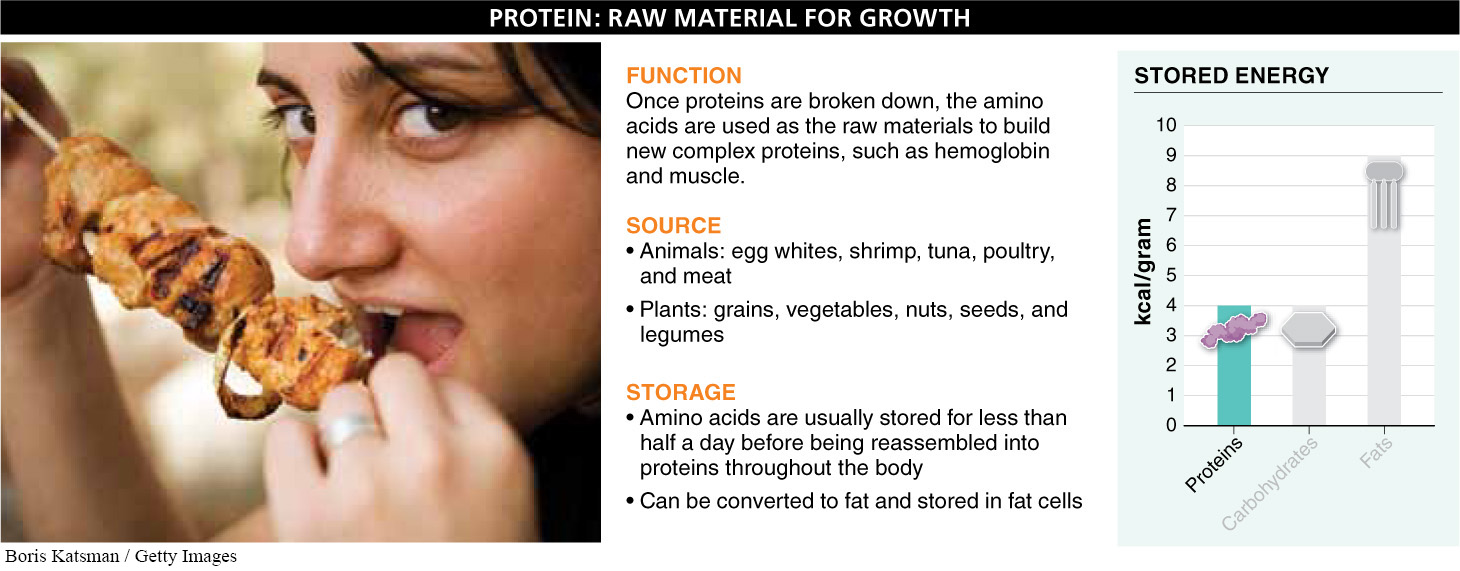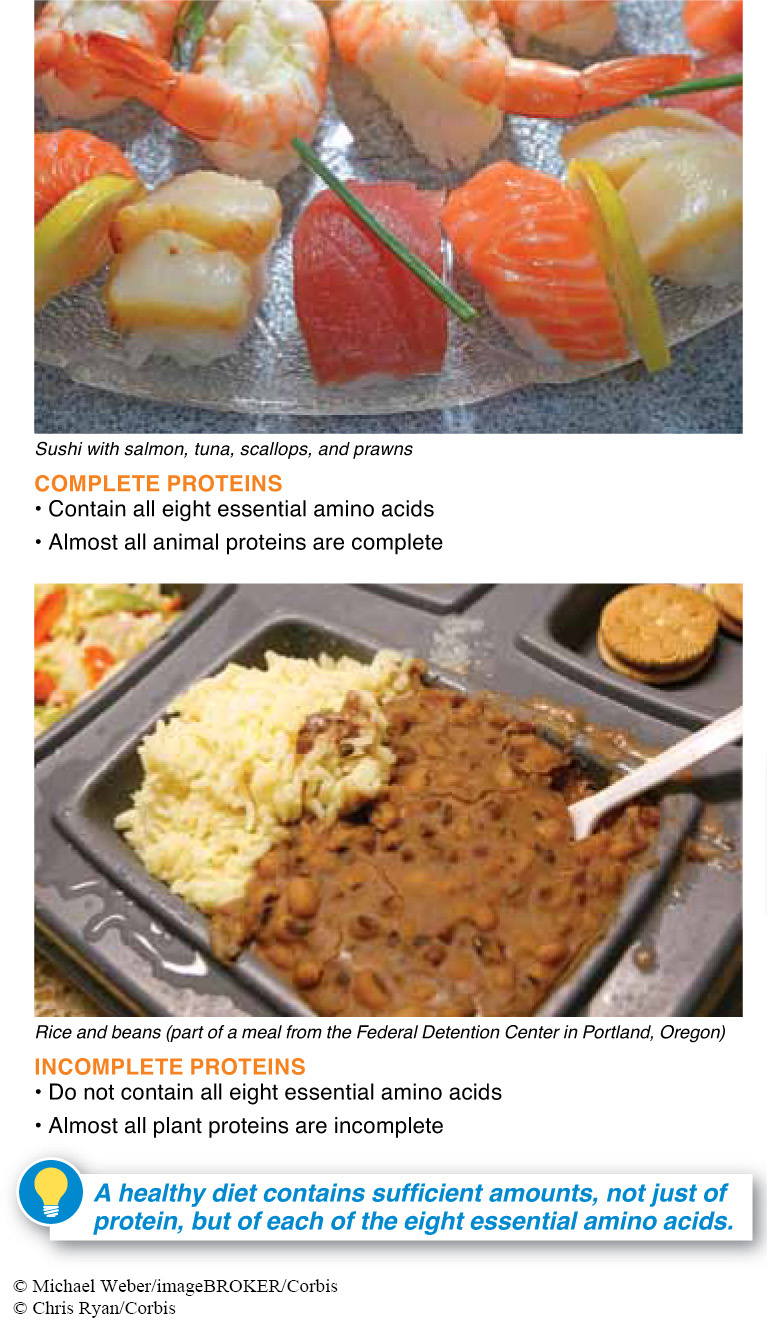22.5: Proteins in food are broken down to build proteins in the body.
When you are on the verge of starvation, any type of food can save you. So from that perspective, it’s true that calories are all that matter. But for optimum health, organisms must consume many types of nutrients. In this section and the next, we investigate the chief nutritional features of the three types of calorie sources: proteins, carbohydrates, and fats. We begin by investigating protein, a vital component of the diet and essential structural material in the body.
Proteins: Raw Material for Growth What are proteins, and what is their role in the diet? Protein in our diet is principally a building material. As described in detail in Sections 2-15–2-19, protein molecules are made of long chains of smaller molecules—amino acids—linked together, like beads on a string. Once eaten, protein molecules are broken down into the individual amino acids, much like removing the beads from the string one at a time. It’s only in the form of individual amino acids (and, occasionally, polypeptides with just two or three amino acids) that proteins can be absorbed by the digestive system. Our bodies can then reorder the beads, making proteins that are different from those we ate.
The process of protein digestion and protein rebuilding does seem a bit inefficient: we consume entire, intact protein molecules such as those of muscle cells or hemoglobin, from chicken or fish or some other animal, which we then break down to individual amino acids that are used to construct the exact protein molecules needed by the body.
Besides serving as building materials, the proteins we build from amino acids function as enzymes, catalyzing chemical reactions (see Sections 2-18 and 2-19). Proteins, whether from our diet or from our own body tissues, can also be broken down to release energy or to be converted to and stored as fat. Protein breakdown happens, for example, when we are consuming too few (or too many) calories to sustain necessary growth and activities. It also happens during a long exercise session. Our bodies can use protein as fuel because we have a variety of methods of converting one type of chemical to another to release or store energy (see Section 4-18). The breakdown of proteins for energy generates 4 kilocalories per gram. However, when a protein is broken down for energy, the nitrogen it carries cannot be used to build new proteins; instead, it is excreted in our urine. In essence, burning protein for fuel wastes valuable nitrogen (which is not present in carbohydrates and lipids)—nitrogen that could be used for building protein.
There are a great many sources of dietary protein, from both plants and animals (FIGURE 22-7). Animal sources include egg whites, shrimp, tuna, lobster, chicken, turkey, and all meat products. Plant sources of protein include grains, vegetables, nuts, seeds, and legumes, such as beans.

Figure 22.7: Versatile proteins. Besides serving as building materials, proteins can be broken down to release energy or can be stored as fat.
Q
Question
22.2
Why does Diet Coke (but not regular Coke) taste bitter if you leave it in the sun for a few days?
Try this. Put one can of Coke and one can of Diet Coke somewhere they’ll get hot, and leave them for a few days. Then taste them. The Diet Coke will lose its flavor and taste bitter, even if you cool it down, while the Coke will taste fine. What’s going on? Diet Coke, but not regular Coke, is sweetened with aspartame (NutraSweet is the brand name). Aspartame is made by linking together two amino acids, aspartic acid and phenylalanine—each of which tastes bitter by itself. When the two are joined as aspartame, however, the taste is very sweet. The reaction by which aspartic acid and phenylalanine are linked together can be reversed by heat. So if you leave a can of Diet Coke in a hot area, the aspartame decomposes to the bitter amino acids. They aren’t harmful, but they aren’t very tasty either.
Are all proteins the same, or do they vary in important ways? Animals, including humans, require 20 different amino acids to make proteins. Most animals, however, can produce only about half of these amino acids themselves—for example, we can make only 12 of the 20 amino acids. The 8 amino acids we cannot produce we must get from the food we eat. For that reason, the 8 amino acids we must consume in food are called the essential amino acids, and the remaining 12 are called non-essential amino acids.
All proteins are not created equal. Protein-containing animal products vary in their amino acid composition. All eight of the essential amino acids are found in milk, eggs, meat, poultry, cheese, and fish; these animal products have “complete” proteins (FIGURE 22-8). On the other hand, most proteins that we get from eating plants are not complete. Corn proteins, for example, have only six of the essential amino acids, as do beans (although they don’t have the same six). In fact, with only a few exceptions (including soybeans and quinoa), plant proteins do not have all eight. A healthy diet is one containing not just a sufficient amount of protein but a sufficient amount of each of the eight essential amino acids that we need to make proteins. Consequently, we must know about the amino acid content of the proteins we eat in addition to how much protein the food contains.
How and where do we store proteins? Proteins and the amino acid pool they generate on digestion cannot be stored very long in our bodies, usually less than a day. By that point, they are broken down and the nitrogen we don’t need is excreted. Because our bodies are making proteins constantly, it is important to take in all of the essential amino acids over the course of each day.
Q
Question
22.3
Why is it beneficial for vegetarians to eat beans and corn over the course of the same day?
The recommended daily intake of protein is approximately 0.8 grams per kilogram of body weight. This translates to about 45 grams of protein for a 120-pound woman (and about 25 additional grams per day for pregnant or lactating women) and 60 grams for a 160-pound man. Exercising athletes can require double or even triple this amount, but it is important to remember that it is the exercise that generates the additional need. Protein on its own does nothing to stimulate muscle growth; it simply serves as the source for the raw materials.

Figure 22.8: Animal versus plant proteins.
Animals aren’t the only organisms that need protein. Every organism—even plants—must build enzymes and so needs protein. This is dramatically apparent in the Venus flytrap, a plant that captures and consumes insects in order to acquire protein. It does this with highly elastic, curved leaves. Water pressure inside the V-shaped leaf causes it to expand into an unstable, stretched-open position that is on the verge of snapping closed. When an insect or spider lands on the leaf, it triggers an electrical signal that causes a brief, rapid change in the water pressure inside the leaf. The change in water pressure is enough to cause the leaf to snap shut, capturing the insect. The plant then releases digestive juices that break down the insect into its usable nutrients. Venus flytraps grow in places where the soil is of poor quality, and especially where it’s low in nitrogen; they can extract nitrogen from the animal prey they capture. The green leaves and stems of Venus flytraps, however, should serve as a reminder that these plants are also photosynthetic. And, in fact, they gain nearly all of their energy by harnessing the energy in sunlight to build sugars. The nitrogen they need (and resort to carnivory to obtain) helps them build the enzymes necessary to conduct photosynthesis.
TAKE-HOME MESSAGE 22.5
Animals consume three different types of macromolecules for calories: proteins, carbohydrates, and fats. Proteins provide raw materials for growth and for the production of enzymes. Food sources of protein vary in amino acid composition. Humans require 20 amino acids for building proteins, and 8 of these, called essential amino acids, can be supplied only by the diet.
How do essential amino acids differ from non-essential amino acids? How do complete proteins differ from proteins that are not complete?

